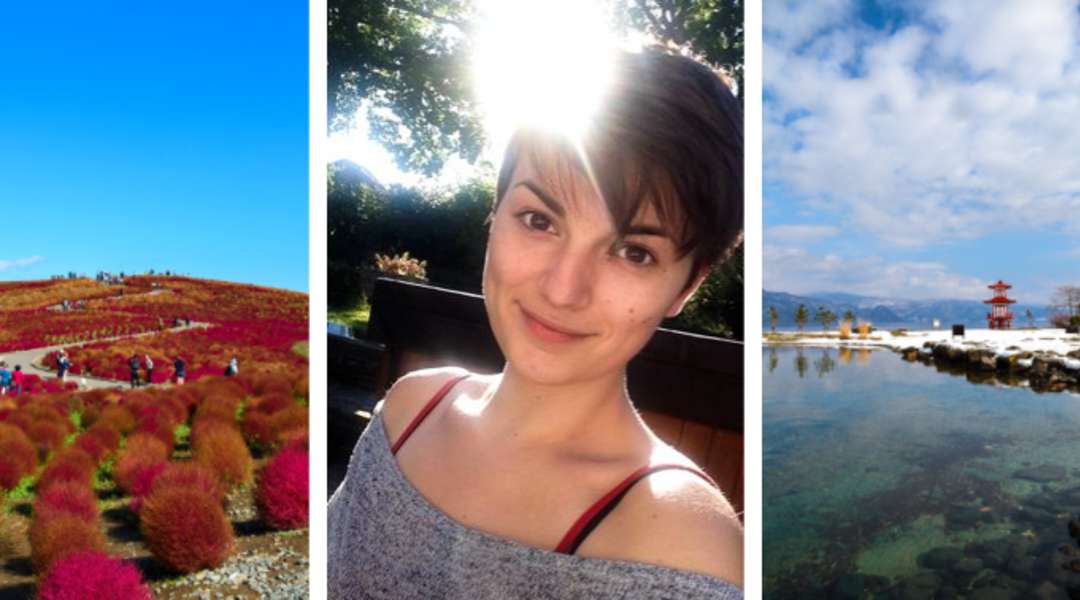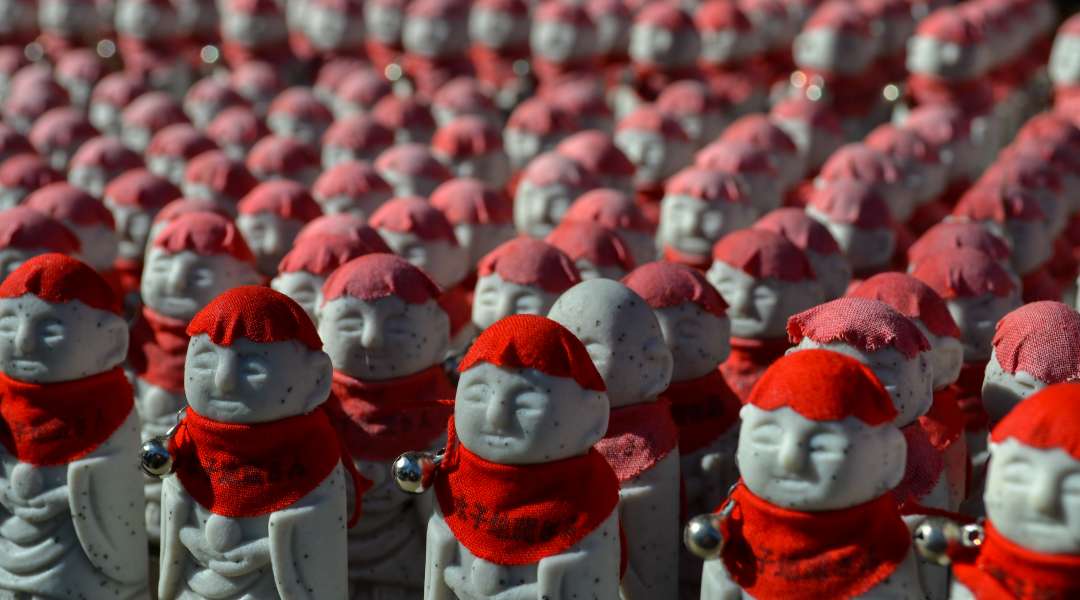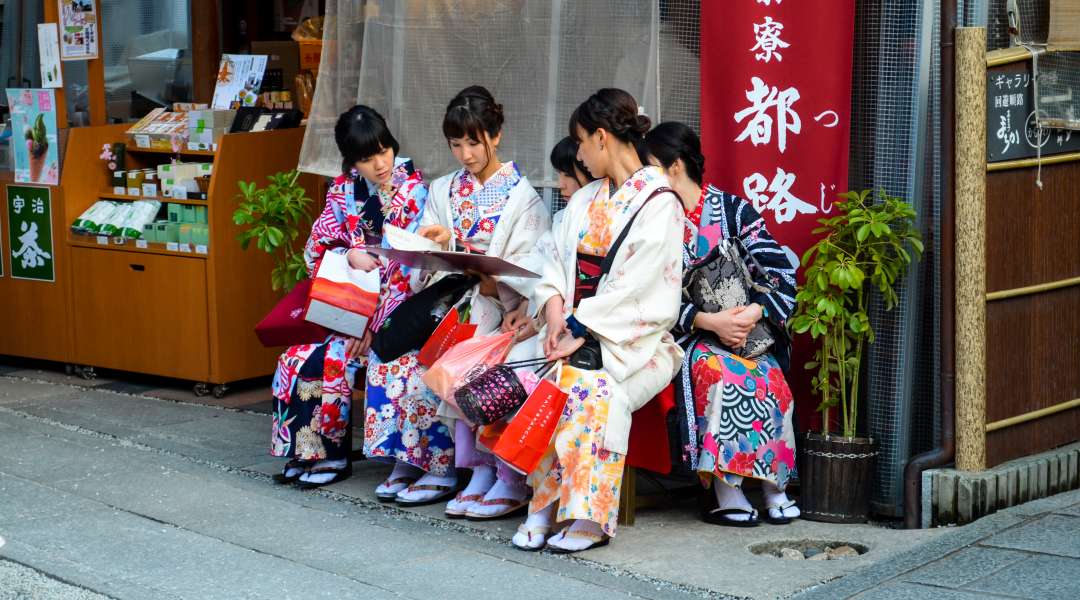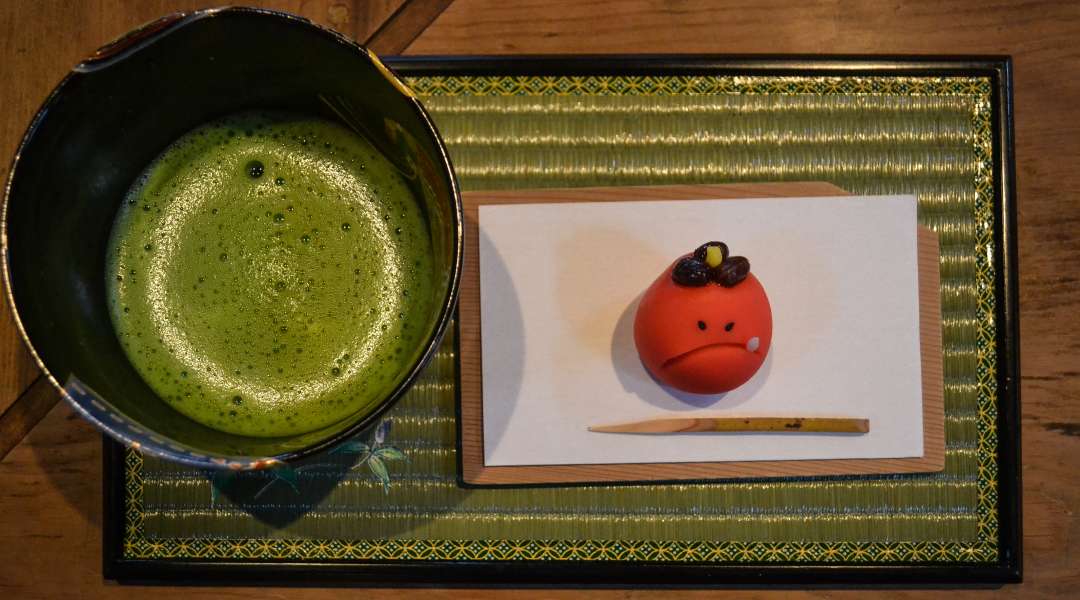
Jo Davey is a long-time Japan fan and British travel writer who’s currently writing Bradt’s Guidebook to Okinawa and Japan’s Southwest Islands. She was in the middle of guidebook research when the global pandemic hit, and sadly had to abandon the islands and hie herself back to London so, naturally, she's just as eager to get back there as the rest of us are - and then some. She covers a whole swathe of topics and countries in her writing but always ends up returning to Japan. She's lived and worked in Japan, too, so we picked her brain on her many experiences and what makes Japan precisely the place she wants to write, talk and wax lyrical about.
Hi Jo! Thanks for talking to us today. These pictures you've taken and provided for us today are amazing! What was it that first got you enthusiastic about Japan?
Honestly, Japan wasn’t so much my choice as my sister’s. She’s a doctor with a penchant for martial arts, so when she had to do an elective abroad, she chose Japan for Judo. She took me with her and that was it. I turned up clueless in Tokyo at the age of 18 and was head over heels. There are so many reasons why I’m enthusiastic about Japan – and I discover new, incredible things each time I visit – but I can recall the exact moment I fell in love with the country.
We had arrived late and were taking a jet-lagged walk through Asakusa around midnight when we came across some gas works blocking the pavement. There was a team of about ten builders and, as two young women walking at night, we were on high alert. We began to walk past and, as predicted, the men stopped working and turned to us – and then bowed. For us it was unprecedented. Where we had expected catcalls, we found courtesy.
I’m pretty sure they expected us to walk on rather than gawp like koi, but once we had moved past them and our shock, I turned to my sister and said “I have to come and live here”. I was back within the year.

How many times have you been and to where?
My job allows me a lot of freedom when I travel, so when I go to Japan I get to spend a good chunk of time there. In total I’ve been six or seven times but some of those were for months on end.
I was very lucky when I lived there as my bosses were unfathomably flexible and let me flit off to explore the entire country. It feels like there are few places I haven’t been, then other days I feel I’ve barely touched the surface. Listing those I’ve visited would make for remarkably dull reading, but a few of my favourites are Yakushima and Iriomote in the islands, Kagoshima, Obuse, Otaru, Takayama, Ishinomaki, Kyoto and of course, Tokyo.

How did you end up working in Japan and what was it like?
That’s a strange and tortuous tale. I was baking macarons for my one-time hairdresser at her home in France and she claimed her new friends would be very impressed.
She had met a Japanese-French couple in an insurance waiting room the year before and bonded over speaking English. Sylvain and Rieko had recently moved to Japan to set up a pâtisserie, having run a Michelin-starred restaurant in South Korea. She put me in touch and before I knew it I was living in a rural area just north of Tokyo with a fantastic Japanese host family.
I love being out of my element but I was definitely in above my head from day one. As it turned out, it was actually a restaurant and they had enough pâtissiers – I ended up being Sylvain’s right-hand woman and helped run the show, gut fish, plate up, shell sazae and everything in between. It was genuinely the best time of my life. I learned so much and Sylvain and Rieko were like surrogate parents who introduced me to onsen, fed me and took me travelling. Better still, the area was beautiful and attracted a fascinating bunch of people. For a year I was surrounded by foodies, farmers and rice fields, while Tokyo was a short train away.

What was the biggest culture shock for you?
I’ve always felt very at home in Japan, which was arguably the most shocking thing. I maintain there are a lot of aspects to Japanese culture that British people respect and agree on so I think that helps. Even simple commonalities, such as queuing: it’s something Brits are famed for but I promise Japanese people out-queue us any day of the week. There’s something homely and familiar in those similarities.
All of my family have now visited multiple times (we’re arguably all addicted) and the one thing that people always mention on their first trip is the lack of gum and rubbish on the streets. You almost don’t notice it because it’s something missing, but once you see it you can’t believe just how clean even the capital is. It’s a small detail that’s hugely representative of Japan’s culture.
The lack of English, spoken and on signs, was also quite the wake up call when I first starting going, but that’s changed a lot since.

If you could pick from any part of Japan or Japanese culture, what is the one thing you would have introduced into the UK?
I’m probably being cheeky choosing such a broad answer but here goes: appreciation.
I feel that Japan really appreciates things in a way we don’t. They take time to appreciate arguably mundane events, like making tea, rendering them incredibly special. In traditional sumi-e ink paintings, artists are taught to appreciate the value of blank space as it can say and do just as much as a brushstroke. What isn’t there is as important as what is.
Sounds and nature are also deeply appreciated: there’s a little known list of the “100 soundscapes of Japan”, which is a magnificent monument to indigenous sounds around the country. Visitors and locals are encouraged to seek out and appreciate the sounds of wind through the pine trees at Oka Castle ruins, the cracking drift ice in Abashiri and even the whistling of the female divers in Ise.
And of course, there’s the food. As a chef out there, I really appreciated the seasonality of Japanese food. Not only does it mean every ingredient is at its best, but there’s a wonderful sense of excitement when chestnut, strawberry, mozuku seasons come round. It makes you really appreciate and anticipate your food.

How have you been keeping in touch with Japanese culture, whilst we’re currently unable to get there?
Writing a book about Japan certainly helps! My entire day revolves around the country, much to my delight. Outside of work, I’ve been studying Japanese as much as possible (trying to make up for lost language) and making all of my favourite dishes – I can’t go for very long without katsudon or okonomiyaki.
Luckily I have friends out there who are happy to keep me updated and in touch. Having also dragged many of my friends and family out there, I have a healthy Japan fan base at home with whom I can lament daily.

What do you think the secret is to getting underneath the surface of Japan?
Time is obviously a big consideration, but not everyone has that luxury. Quality over quantity is important though. I think it’s very tempting when doing such a big, expensive trip to try and fit in as much as possible, but a whirlwind tour means you miss a lot of real, Japanese life. After all, the people make the place.
Much as Tōkyō feels like home, I’d advocate getting out of the big cities and into local life. It doesn’t have to be incredibly remote – day trips will do the job. The slower, rural pace is a great way to feel more rooted and less like an overwhelmed spectator. Bradt, who I’m writing for, publishes ‘Slow Travel’ guides designed to take you on an intimate, in-depth tour of an area. Unfortunately they don’t yet do these for Japan, but I think it’s a great idea for truly getting to know somewhere.
Travelling further afield does mean making peace with the fact you’ll be surviving on little to no English. Embrace it! I’m a firm believer that we should learn a bit of language for anywhere we go. A little effort goes a long way, especially in Japan, and it’ll help you gain access to genuine Japanese experiences. Go to a local izakaya where you can’t read the menu, find a back alley noodle bar filled with salarymen, get off the train a stop early and walk through the neighbourhood. You’ll be amazed what you’ll find and they’re usually the stories you end up telling years down the line.

Where do you most recommend visiting and where are you hoping to visit next?
I’d be a really terrible publicist if I didn’t say the islands, but honestly I chose to write about them for a reason. They’re so overlooked, untouched, remarkably varied and it’s hard to believe they’re even Japan. I have a friend who, despite my best efforts, has never been interested in visiting Japan – until she saw a picture of the bridge spanning the turquoise stretch of sea between Miyakojima and Irabujima. Once she’d called to confirm that it was indeed Japan, she was suddenly a lot more interested in my expertise…
The true beauty of the islands is their variety though: you have virgin forest, uncharted jungle, indigenous wildcats, capital cities and uninhabited beach isles full of starsand. It’s Japan, but not as anyone else knows it.
I will be going back to the islands to finish my research, but I of course have a whole list of places to visit outside of work. I’d love to see Aogashima and Sadoshima, as well as hike more in Kyushu, the Alps and Shikoku.

Do you have any particular food recommendations?
Katsudon, oden and nikujaga are my current cravings as they’re the ultimate comfort foods and perfect for winter. My family loves okonomiyaki but I’m a big fan of its messier cousin, monjayaki. Japan does incredible seafood, which isn’t really my area, but their freshly grilled squid is mouthwatering – you’ll wonder why you ever bothered with battered calamari.
Japan is the perfect place for adventurous foodies – chicken sashimi is a delight if you can find it – but the unfamiliar doesn’t have to be scary. My favourite thing is to go into a konbini and just start buying snacks I don’t understand. I’ve discovered some lasting favourites that way – such as the inexplicably named crispy moist chocolate.
Finally, I heartily recommend exploring Japan’s alcohol scene. I find most Japanese soft drinks too sweet (and I have a sweet tooth) but their sake is perfection. I like mine cold, sparkling or flavoured with plum (umeshu) or yuzu (a Japanese citrus). I have yet to find someone who doesn’t like umeshu, even those who don’t like traditional sake.

What’s your favourite memory from living in Japan?
Honestly, every day was worth writing home about but the best moments usually involve people rather than places – that’s where I got a real sense of belonging.
As I mentioned, where I lived was filled with foodies and farmers. The father of the Hagino family was a wine merchant too so that usually flowed long and free. One day I got invited to a dinner party hosted by their neighbour, Yumiko Takayama, an editor at Elle Gourmet. She had invited a Japanese chef who was visiting from her home in Sweden, who cooked our dinner using ingredients from the local farmers. The farmers – a remarkably young demographic – also came, and some of Hagino-san’s colleagues brought the wine.
My host family didn’t actually come, so it was just me plonked down at a banquet table of incredible food and wine, surrounded by this vibrant group of young food professionals and so much laughter. Someone brought a cajón drum along and started singing and playing while we devoured and drank into the wee hours. It was a bacchanalian, beautiful snapshot and I was utterly baffled that I got to be part of it.

This month we’re looking at the word ‘fuubutsushi’, meaning the small things that signal the changing of the seasons like cherry blossom or autumn leaves, for example. What's your favourite fuubutsushi and why?
Another tough choice. I’d be tempted to say hydrangea flowers coming out. I visited a garden of them in full bloom once and I’ve never seen such gigantic, colourful flowers. It also coincided with firefly season, so it was pretty special at twilight.
However, I think I’d have to say the coming of the rain. It’s one of the 72 micro-seasons (ko) of Japan, from February 19th-23rd. I’ve always said Tōkyō has a particular smell, which sounds ever so slightly mad, but I swear it does. There’s a whole host of aromas that combine to make it, but one of them is the smell of fresh rain on the pavement. That petrichor smell, mixed with incense, always makes me think of the Senso-ji temple – the first place I ever saw in Japan.
I always thought I was alone in this until last year, when my family was travelling from Tohoku to Tōkyō by Shinkansen. About twenty minutes from Shinjuku, my sister sat up in her seat, turned to me and said “Can you smell that? It smells like Tōkyō! It smells like home!”
Thanks very much for your time, Jo!
All photographs were taken by Jo herself (including one by her sister, Laura!) but if you'd like to keep up with Jo and her travels throughout Japan and beyond, make sure to check her out on Instagram and Twitter.

















































